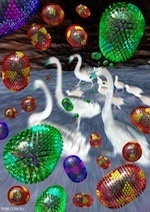A characteristic difference between highly and non-highly pathogenic avian influenza strains is the presence of an extended, often multibasic, cleavage motif insertion in the hemagglutinin protein.
Conclusions
This highly pathogenic H7N3 avian influenza strain acquired a novel extended cleavage site which likely originated from recombination with 28S rRNA from the avian host. Notably, this new virus can infect humans but currently lacks critical host receptor adaptations that would facilitate human to human transmission.
Avian influenza virus graphic courtesy of Russell Kightley Media



 Your new post is loading...
Your new post is loading...








This is rather sinister! Not only can influenza viruses mutate, for antigenic drift, and reassort with one aother for antigenic shift - they can now recombine with HOST sequences to increase pathogenicity!